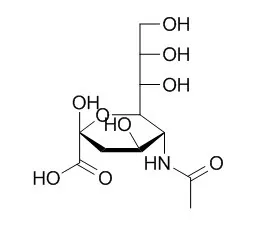| In vitro: |
| Infect Immun. 2014 Dec;82(12):5235-45. | | Aeromonas salmonicida binds differentially to mucins isolated from skin and intestinal regions of Atlantic salmon in an N-acetylneuraminic acid-dependent manner.[Pubmed: 25287918] | Aeromonas salmonicida subsp. salmonicida infection, also known as furunculosis disease, is associated with high morbidity and mortality in salmonid aquaculture. The first line of defense the pathogen encounters is the mucus layer, which is predominantly comprised of secreted mucins.
METHODS AND RESULTS:
Here we isolated and characterized mucins from the skin and intestinal tract of healthy Atlantic salmon and studied how A. salmonicida bound to them. The mucins from the skin, pyloric ceca, and proximal and distal intestine mainly consisted of mucins soluble in chaotropic agents. The mucin density and mucin glycan chain length from the skin were lower than were seen with mucin from the intestinal tract. A. salmonicida bound to the mucins isolated from the intestinal tract to a greater extent than to the skin mucins. The mucins from the intestinal regions had higher levels of sialylation than the skin mucins. Desialylating intestinal mucins decreased A. salmonicida binding, whereas desialylation of skin mucins resulted in complete loss of binding. In line with this, A. salmonicida also bound better to mammalian mucins with high levels of sialylation, and N-Acetylneuraminic acid appeared to be the sialic acid whose presence was imperative for binding.
CONCLUSIONS:
Thus, sialylated structures are important for A. salmonicida binding, suggesting a pivotal role for sialylation in mucosal defense. The marked differences in sialylation as well as A. salmonicida binding between the skin and intestinal tract suggest interorgan differences in the host-pathogen interaction and in the mucin defense against A. salmonicida. | | J Med Chem. 1996 Mar 15;39(6):1314-20. | | Synthesis and biological evaluation of N-acetylneuraminic acid-based rotavirus inhibitors.[Pubmed: 8632438] | Rotavirus can cause severe gastrointestinal disease, especially in infants and young children, and is particularly prevalent in Third-World countries. Therefore, the development of potential inhibitors of this virus is of great interest.
METHODS AND RESULTS:
The present study describes the synthesis and in vitro biological evaluation of a number of N-Acetylneuraminic acid-based compounds as potential rotavirus inhibitors.
CONCLUSIONS:
Our data suggests that it is indeed possible to inhibit adhesion of the virus, and hence in vitro replication, with carbohydrate-based molecules, although this inhibition does appear to be strain dependent. | | Biosci. Biotech. Biochem. 1994, 58(9):1720-2. | | Growth-promoting Effects of N-Acetylneuraminic Acid-containing Substances on Bifidobacteria.[Reference: WebLink] |
METHODS AND RESULTS:
The use of N-Acetylneuraminic acid, sialyl-lactose, and glyco-macropeptide by bifidobacteria and lactobacilli, and their growth-promoting effects on B. longum, B. breve, B. bifidum, and B. infantis were investigated.
CONCLUSIONS:
The data presented here suggest that fortification with N-Acetylneuraminic acid-containing substances of infant formula may provide formula-fed infants with a function that human milk possesses.
|
|






 Cell. 2018 Jan 11;172(1-2):249-261.e12. doi: 10.1016/j.cell.2017.12.019.IF=36.216(2019)
Cell. 2018 Jan 11;172(1-2):249-261.e12. doi: 10.1016/j.cell.2017.12.019.IF=36.216(2019) Cell Metab. 2020 Mar 3;31(3):534-548.e5. doi: 10.1016/j.cmet.2020.01.002.IF=22.415(2019)
Cell Metab. 2020 Mar 3;31(3):534-548.e5. doi: 10.1016/j.cmet.2020.01.002.IF=22.415(2019) Mol Cell. 2017 Nov 16;68(4):673-685.e6. doi: 10.1016/j.molcel.2017.10.022.IF=14.548(2019)
Mol Cell. 2017 Nov 16;68(4):673-685.e6. doi: 10.1016/j.molcel.2017.10.022.IF=14.548(2019)